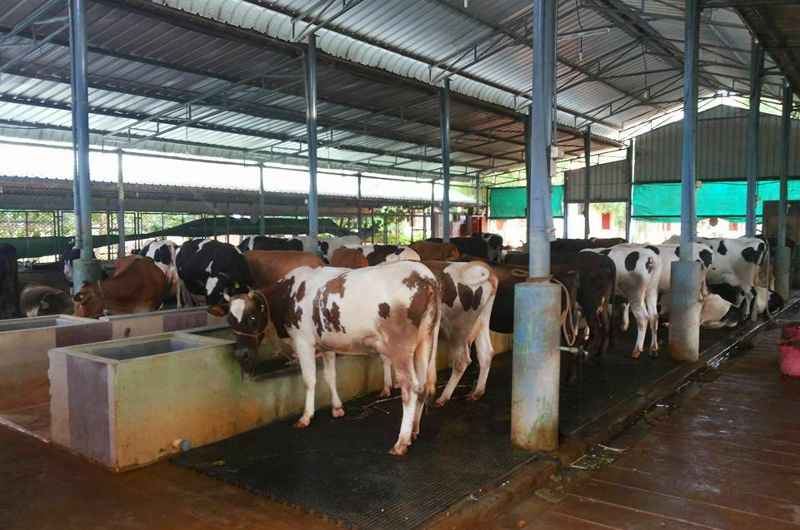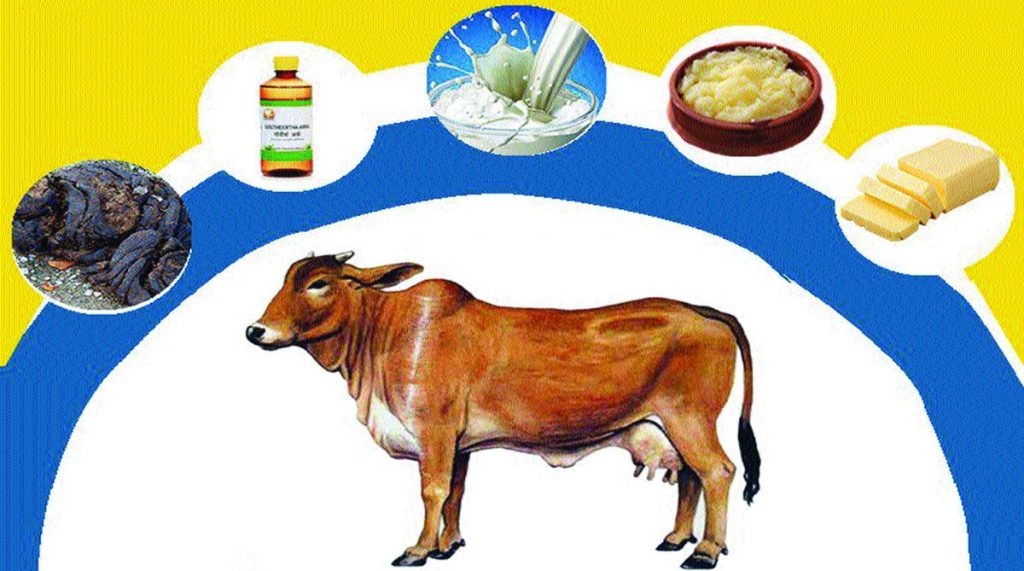
Cows shouldn’t be considered a burden on the country and society even if they are old, sick, blind, disabled or have stopped giving milk. It is not the right thing to do. One of our religious text, The Puranas, at various instances mention “Gobare Vasate Lakshmi”, meaning “Lakshmi, the Goddess of Wealth resides in cow’s dung”. This implies that cow dung and urine are a source of wealth and prosperity. Thus, cows are also revered as ‘Kamdhenu’.
The slaughter of cows and other cattle is increasing with every day. So is the poverty level among the poor in the country. This clearly demonstrates that mechanized farming techniques, chemical fertilizers and poisonous pesticides have not improved the health and economic well-being of the people. The situation is very grave now and continues to deteriorate further. It is very evident that blindly adopting modern methods at the cost of our traditional cow-based farming has not yielded any positive results nor provided any sustainable development and has rather resulted in long-term losses for the nation.
Chemicals are not the natural choice of food for the soil. Chemical fertilizers do tend to increase food production in the beginning, but subsequently, the yield decreases and reaches a point where the land becomes infertile and no amount of fertilizers can improve production. These apart, the crops are laced with pesticide residues, the cost of farming is always on the rise and there’s inflation, farmer health gets effected and poverty keeps increasing. Such is the harmful impact of chemical fertilizers and poisonous pesticides. Moreover, setting up of these fertilizer and pesticide industries require huge investments, which again is an economic drain on the country and its people.
The agricultural scenario wouldn’t have been the same in India had our cows not been treated as a burden and slaughtered mercilessly. Our agricultural production would not have been so abysmally low if we understood the benefits of cow dung and urine, and utilized them in a scientific manner, initiated further research to improve their efficiency and discovered further applications for improving yields. Since farmers would have owned their livestock, they would not have to depend on the market for agricultural inputs, which also means that their cost of cultivation would be near zero and completely in sync with nature. Low production cost would mean lowering of prices and the government wouldn’t have to resort to subsidies on food, fertilizer and various other doles. There would have been lesser incidence of tax on the masses due to which poverty and inflation would have stayed in control, with growth and prosperity as the order of the day.
Cow dung is the natural food for the soil and helps in maintaining its fertility. In fact, if the cow dung is composted before adding it to the soil, it slowly increases the productive capacity of that land, rather than decreasing it. This is precisely why land in India is still fertile, while lakhs of hectares of land in developed nations have been rendered barren due to unrestrained use of chemicals over the past 60-70 years. The governments and its people in these countries have realised the consequences of their actions and have undertaken organic farming and the use of cow dung for cultivation. We, in India, sadly continue to falsely believe in chemical farming.
In the last 10-12 years, it has been effectively proven that cow dung compost is not inferior to chemicals. The NPK (nitrogen, phosphorous, potassium) composition in compost is as much as it is in chemicals, with 0.5-1.5% nitrogen, 0.5-0.9%phosphorous, and 1.2-1.4% potassium. These figures have been established after multiple investigations by renowned institutions. The process of making such compost is known as ‘NADEP’ and this method was invented by Mr Narayan Rao Devrai Pandari Pandey, who is fondly known as ‘Nadep kaka’. He has also published this very simple process. Every farmer can prepare it at his farm or at home, and it involves no cost except physical labour.
In the last 10-12 years, it has been effectively proven that cow dung compost is not inferior to chemicals. The NPK composition in compost is as much as it is in chemicals, with 0.5-1.5% nitrogen, 0.5-0.9%phosphorous, and 1.2-1.4% potassium.
One needs a 19 feet long, 6 feet wide, and 3 feet high tank or a trench in the ground to prepare about 180 cubic feet of compost. The ingredients are about 100 kilograms of cow dung, around 1750 kilograms of farm and vegetable waste like dried leaves, branches roots, etc. and green matter, refined and dried soil from the fields to the tune of 1750 kilograms as well as about 1500 – 2000 litres of water, as required. Farmers don’t need to spend a penny on the raw material as everything is readily available from their land and cattle. This mixture is coated with cow dung paste and soil before the tank is sealed. The mixture stays in the tank or trench for about 90-120 days, during which it becomes compost. The compost is then appropriately sieved to get about 3 tonnes of fertilizer from as little as 100 kilograms of cow dung. A bag of urea currently costs around Rs 300. We can get about 50 tonnes of compost a year (approx) from a single cow’s dung, leading to great savings for the nation.
The above formula clearly demonstrates that a cow will give back more value to its owner if the farmer uses the cow dung and urine judiciously, than what is spent on its food. The experiment also proves that killing cows or treating them as an unnecessary burden can be very harmful for the economic condition of the country. Russia has conducted studies on the use of cow dung and experienced its functionality. Applying cow dung paste on the outer walls of buildings prevent harmful radiations from seeping in. The effects of pouring ghee into a havan has also been studied in Russia and the findings hinted at the absence of germs or bacteria in the neighbouring areas.
Cow urine is very beneficial for farming. It acts as a natural pesticide without harming the land. It is also used in treating various human ailments and worms in the stomach. The uses of Gaumutrahas not been fully established and it can be a good area of research.

It is common knowledge that we get bio-gas free of cost from cow dung. This gas can be used for cooking and lighting. Unfortunately, gobar gas plants, which should have been installed in every village by now, has not seen such widespread penetration. If such plants had been set up in abundance, there would have been no shortage of energy and electricity. The pressure on trees to meet energy requirements would have considerably lessened and the forest cover would have turned green once again. Our over-burdened energy mechanism could have diverted its resources from rural demand to addressing industrial needs, thereby improving the economic condition of our country. Rural households could have access to clean, smokeless energy. Harmful smoke and fumes are a major cause of eye ailments among rural people today. Cow-dung doesn’t have a cost attached to it and the slurry obtained from gobar gas plants are more fertile because the removal of gas from cow dung increases its nutritional capacity.
Our over-burdened energy mechanism could have diverted its resources from rural demand to addressing industrial needs, thereby improving the economic condition of our country.
The income generated from the complete utilization of cow dung more than makes up for the cost of maintaining the cattle. The milk and labour of the cows are additional benefits to the farmer, which eventually adds up to increased income, a better lifestyle and improved milk supply for their children. The above examples again prove that cattle are of great value, and even after their death, their skin, bones and some parts of their body are a bonus for the farmer. Killing such an animal is a huge blunder.
The evidence of a flourishing cattle population in ancient India can be found in Lord Buddha’s time. Those possessing the maximum number of cows was accorded the status of Shresti, signifying them as the wealthiest in the city. One such Shreshti of the then Pataliputra (present day Patna) invited Bimbisar, the King of Magadh, for dinner. It was a commonly practised custom to make arrangements suiting the status of the invited guest – the higher the eminence, the more elaborate the hospitality. In keeping with this tradition, the Shreshti used rare and precious stones that glowed in the dark, to light up his home as the King dined in that light. This episode goes on to show how rich and prosperous our nation was then. Research and historical records go to say that Shreshtis during those times owned more than a lakh cows each.
Organic vegetables and fruits command as much as 2-3 times the price of chemically grown food in the European markets and the demand is ever increasing. Farmers and other producers in Europe are increasing the proportion of organic fertilizers in their cultivation. Indian tea producers have secured an order at 2.5 times the price for his organically grown tea. There are other big buyers ready to place large orders but due to the lack of availability of compost, the tea company is unable to increase organic production and meet rising demands. The importance of compost and its necessity is clear from the evidences mentioned above.
(The author is ex-Rajya sanchalak, Gausamrakshana Prakosht, BJP-Karnataka)
